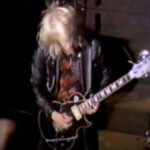Elvis Presley, the King of Rock ‘n’ Roll, is almost inseparable from the image of a guitar. From his early Sun Records days to the glitz of Las Vegas, a guitar was a constant companion, an extension of his musical soul. While often seen with electric guitars in his explosive performances, Elvis’s journey with music began with the humble acoustic guitar, and it remained a cherished part of his musical expression throughout his life.
He strummed his first chords on an acoustic at the age of 11, a gift that ignited a lifelong passion. This initial acoustic guitar was more than just an instrument; it was his gateway to music, songwriting, and self-expression. As Elvis rose to stardom, his collection expanded, featuring iconic instruments that became symbols of his legendary career. Let’s explore some of the acoustic guitars that played a significant role in shaping the sound and image of Elvis Presley.
The 1955 Martin D-28: The First Album Icon
Before the gold lamé suits and stadium concerts, there was a raw, young Elvis with his acoustic guitar. In the mid-1950s, during the dawn of his explosive career, Elvis favored Martin guitars. Initially playing a 1942 Martin D-18, he soon traded up to a newer 1955 Martin D-28 at O.K. Houck Piano Co. in Memphis, a store frequently visited by the burgeoning star.
This 1955 Martin D-28 acoustic guitar holds a special place in music history. It’s the very guitar gracing the cover of Elvis’s groundbreaking debut album, a visual cornerstone of rock and roll history. Beyond its visual prominence, this D-28 was known for its rich, resonant tone, perfectly suited to Elvis’s evolving sound. Adding to its unique character was a custom leather cover, handcrafted by a music store employee, giving it a distinctive look that matched Elvis’s burgeoning style. This guitar wasn’t just an instrument; it was a partner in the creation of rock and roll history.
The 1956 Gibson J200: A Symbol of Rock Royalty
Moving into his rock and roll reign, Elvis’s acoustic guitar choices evolved to match his kingly status. The 1956 Gibson J200 epitomized this transition. This magnificent acoustic guitar, with its large body and ornate appointments, certainly looked the part for a member of rock and roll royalty.
Elvis deeply admired this J200 and played it extensively, particularly throughout his dynamic 1957 concerts and appearances. Its powerful projection and bright tone were ideal for cutting through the roar of enthusiastic crowds. Even after his army service, the sentimental value of this instrument was clear. Upon his return, Elvis had his guitarist Scotty Moore send the well-loved J200 for a refurbishment. Though a brand-new 1960 J200, nearly identical in appearance, was provided for a recording session, the original 1956 model was given a stylish makeover. Gibson replaced the red pickguard with a sleek black one and inlaid “Elvis” on the fingerboard, transforming it into a truly personalized instrument. This revamped 1956 J200 was showcased in publicity shots for “Wild in the Country” and in “Elvis: That’s The Way It Is,” further cementing its iconic status. Elvis loved the 1960 J200 as well, keeping both guitars as cherished parts of his collection. Both the 1956 and 1960 Gibson J200 acoustics remain preserved in the permanent archives at Graceland, testaments to Elvis’s enduring love for the acoustic guitar.
While these acoustic models are central to understanding Elvis’s early musical development and his enduring connection to the instrument, his guitar journey also extended into other territories. He was frequently seen playing various electric guitars and even bass guitars, showcasing his wide-ranging musical interests and talents. Instruments like the Fender Precision Bass and the Gibson EBS-1250 Double Bass, though not acoustic, became visually associated with Elvis through films and photographs, further illustrating his broad engagement with stringed instruments. However, it’s important to remember that the foundation of his musical journey, and a constant thread throughout his career, was his love for the acoustic guitar.
The Enduring Appeal of Elvis and the Acoustic Guitar
Elvis Presley’s relationship with the acoustic guitar was more than just a professional association; it was a personal connection that spanned his entire life. From his first chords as a boy to strumming backstage before stadium shows, the acoustic guitar was a source of comfort, creativity, and connection to his musical roots. Even as he became synonymous with the electric energy of rock and roll, the image of Elvis with an acoustic guitar remains deeply resonant. It speaks to the authenticity of his musical beginnings, his songwriting core, and the enduring power of simple melodies played on wooden strings. For fans and guitar players alike, Elvis Presley and his acoustic guitars represent a timeless blend of musical innovation and heartfelt expression.

